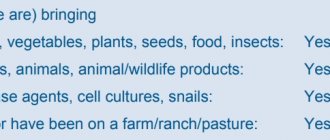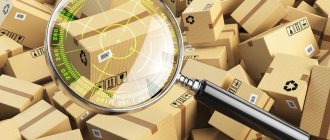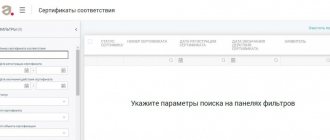The acquisition of inventory items produced abroad is a common occurrence in modern economic conditions. Most often, goods are purchased from wholesale companies that operate in foreign markets. And at the transaction stage, it is important to establish the legality of importing goods into Russia. Checking the customs declaration is not mandatory, i.e. The legislation does not require checking the number of the customs declaration indicated by the supplier in the invoice. However, such control will make it possible to reliably establish the legality of the product and avoid problems with VAT reimbursement for it - a similar consequence of false declaration is most often encountered in practice.
Sections:
- What is a customs declaration and why is it needed?
- What is a customs declaration number
- Control via the FCS website
- Control on the Federal Tax Service website
- Data from the online foreign trade database
- Checking the number in the customs database
For each imported/exported product, an individual customs declaration is drawn up, which contains information about the product, as well as a special registration customs number. Based on this number, control is carried out in order to determine whether the cargo was legally imported into Russia.
These types of checks are not mandatory. Registration numbers are required for tax authorities. However, product owners can also audit the customs form by number. With the help of such control, it is possible not only to establish the authenticity of all transactions, but also to correctly calculate the amount of VAT refund for goods.
Indicators for 2021, check the customs declaration by number online
The statistics of the Customs Union for 8 months amounted to 34 billion, which is 27.5% more than in 2021. Of them:
- Armenia – 317.4 million
- Belarus – 8.8 billion.
- Kazakhstan – 3.2 billion.
- Kyrgyzstan – 384.3 million.
- Russia – 21.3 billion dollars.
Statistics of mutual trade of the Customs Union in percentage terms:
| A country | Export | Import |
| Armenia | 0,9% | 2,3% |
| Belarus | 25,8% | 36,4% |
| Kazakhstan | 9,7% | 22,7% |
| Kyrgyzstan | 1,1% | 3,4% |
| Russia | 62,5% | 35,2% |
Customs statistics of the EAEU show a slight increase in the proportions of mutual trade in 2017. Share of gross indicators in the total volume of foreign trade:
| EAEU countries | The share of trade with third countries in the total volume of foreign exchange. trade (%) | The share of mutual trade in the total volume of foreign trade. trade (%) |
| EAEU | 85,4 | 14,6 |
| Armenia | 72 | 28 |
| Belarus | 47,2 | 52,8 |
| Kazakhstan | 77,7 | 22,3 |
| Kyrgyzstan | 61 | 39 |
| Russia | 91,1 | 0,9 |
Structure of mutual trade in the EAEU:
- mineral raw materials – 27.9%;
- machinery and equipment – 17.7%;
- agricultural raw materials and products – 15.4%;
- metal products – 13.2%.
Statistics from customs authorities indicate that the bulk of supplies of mineral products come from Russia. It accounts for more than 84%. It also leads in sales on the EAEU market:
- machinery and equipment – 55%;
- chemical industry products – 63.5%;
- metals and products made from them – 61.4%.
Customs service statistics demonstrate a change in the dynamics of economic development in the EAEU countries. During the period from January to September 2017, the overall GDP increased by 1.9%. By country:
- Armenia – by 5%;
- Belarus – by 1,%;
- Kazakhstan – by 4.3%;
- Kyrgyzstan – by 5%;
- RF – by 1.6%.
What is a customs declaration and why is it needed?
The customs declaration is the main official document, which confirms that the cargo has passed customs clearance upon import/export. It contains information about:
- total cost of cargo;
- transport involved in transportation;
- participants in the process, namely the recipient and the sender.
This document is filled out on the official form of the customs services and is submitted only electronically. To certify a document, an electronic signature of a legal entity or individual entrepreneur is used. If the paperwork for passing customs is carried out by a customs broker, then his signature is affixed.
The declaration has quite an important meaning, both for Customs authorities and for cargo owners:
- The document serves as the basis for customs officers to allow goods to cross the border.
- Based on the application, it is possible to assess whether the norms of customs legislation were applied correctly in relation to a specific type of cargo.
- Information from the TD serves as a source for calculating VAT.
Types of gas turbine engines
Before you understand what a customs declaration for a car is, you should know that the Customs Code of the Customs Union provides for 4 types of documents:
- Commodity. Applies to all types of products entering the countries of the Customs Union (the Russian Federation is its member) as part of foreign economic activity.
- Transit. Filled out and submitted to the relevant authorities if the goods are moving across the territory of the Customs Union and none of the countries is its importer or exporter.
- Passenger. Submitted to customs when importing or exporting goods, including a car, by an individual.
- Declaration on the vehicle. To be filled in if a vehicle is imported into the Russian Federation from abroad.
By car
If the car was purchased abroad, when importing it into the Russian Federation, you must fill out the appropriate forms. They are drawn up by the person who purchased the vehicle. The inspector will only assure them, having previously verified all the information about the car during the inspection process. Therefore, for those who do not know what a gas turbine engine declaration is for a car, it is better to contact specialists or purchase it in the Russian Federation after completing all the procedures.
When purchasing a car abroad by an individual, in addition to the declaration, you will need to provide a receipt order to customs. Without it, the inspector may not allow the import of the vehicle, which will entail additional costs for its storage in a special warehouse.
On the body
If a car is imported into the territory of the Russian Federation for spare parts, then a declaration must be drawn up for each part that has a number. The body has its own identification number, so the corresponding form must be filled out for it.
To understand what a gas turbine declaration for a body is and why it is needed, you should take into account that without it, after assembling a car in the Russian Federation, it is impossible to register it with the internal affairs bodies, and therefore, to operate it. When issuing a vehicle passport for an imported car, the inspector checks the numbers of all units. If the information in the forms and in fact differs, you will have to spend time and money to bring them into compliance.
On the engine
When purchasing a power unit abroad for its subsequent installation, it must also be declared. The engine serial number is considered a mandatory detail, since it can be used to identify the unit.
Technical condition, age and other characteristics (except for compliance with environmental standards) do not matter. After receiving an import permit, the engine can be installed and changes can be made to the vehicle passport (the serial number must match the information in the customs declaration when preparing the necessary documents with the internal affairs authorities).
So, the declaration is considered the main document in the implementation of foreign economic activity and is subject to mandatory registration. Without understanding what a customs declaration for a car is, it is better not to make purchases abroad, or contact specialists.
Source
What is a customs declaration number
The customs application indicates the registration number under which the document is entered into the database of the Federal Customs Service of the Russian Federation (FCS RF). It is written on the first sheet of the TD in line of column A, as well as on the additional sheet. According to paragraphs. 1 clause 43 of the Instructions approved by the Decision of the CU Commission No. 257 of April 20, 2010, this number has a special format, which is represented by a 21-digit set of numbers, divided into 3 sectors by the sign “/”.
- Sector 1 consists of 8 digits that display the code of the customs authority that registered the declaration.
- Sector 2 includes 6 digits indicating the date (day, month, year) when exactly the document was registered.
- Sector 3 is a set of 7 digits that are assigned to each load individually. This is the ordinal norm under which the entry was made in the customs log.
It is thanks to this number that you can check who, where and when the cargo was imported and accepted, as well as what exactly was included in it.
Today you can check the customs union declaration number in several ways, each of which has its own distinctive features, advantages and disadvantages. Specialized programs have been developed to check TD by its registration number. Some of them provide only the most basic information in the form of the date and place of customs clearance, the type of goods being transported, and the name of the importing company. Since the amount of data in such programs is quite small, their cost is relatively low.
Other programs have broader functionality, thanks to which all received data can be grouped according to certain criteria, for example, a specific importing company or type of product. In addition, if a foreign trade participant uses specialized programs designed for conducting foreign economic activity, then they already have built-in modules for controlling trade activities. Using them, you can study the competitive environment, finding out when and what goods were imported by competitors.
Sea and river transportation check the customs declaration by number online
State register of executed and issued TRCU certificates and declarations of conformity of the Customs Union (EAC):
This is a fairly inexpensive type of cargo transportation. Thanks to which, of course, he could be very popular. But you can use this method of cargo delivery only in areas where sea and river communications are well developed, and there are not very many of them.
The advantages, in addition to the low cost of cargo transportation, are the large capacity of sea and river transport, and the almost complete absence of capacity restrictions.
The disadvantages of cargo transportation by water are the very low speed of movement and small coverage of areas where sea or river communications are developed, and there are ports with special equipment for unloading and loading ships.
Control on the Federal Tax Service website
The website of the Federal Tax Service also has its own service called: “Checking the receipt of information from the Federal Customs Service on documents to confirm the validity of applying the tax rate of 0 percent VAT.” With its help, you can view the data transmitted from customs authorities online.
To track a customs application by number online using this service, you will need to enter the personal TIN of the person who is responsible for financial regulation, as well as information regarding the customs event under which the cargo was placed according to this application.
Traceability of imported goods and labeling: differences
Product traceability is not labeling. There are many differences, we have discussed the main ones.
| Mandatory labeling of goods | Traceability of imported goods |
| The marking code is applied to each unit of goods. | There is no need to apply anything to the product; a RNPT number is assigned. |
| The code must be scanned and the information transferred to the Honest Sign marking system. | The goods are not scanned; the path of the goods is tracked using electronic documents. |
| There is no need to submit additional reports. | Every quarter, a report on transactions with traceable goods is submitted to the tax office. |
| Retail sales are confirmed by a cash receipt. | Information on the disposal of goods is indicated in the quarterly report. |
If labeling requires additional equipment for applying and reading codes, then this will not be required to record traceable imported goods. However, for the purpose of notifying the Federal Tax Service about the import of such goods and submitting reports on transactions with them, it will be necessary to organize electronic document flow.
Askar Rakhimberdiev
CEO of MySklad
Data from the online foreign trade database
Commercial foreign economic activity databases are an effective way to obtain a broader list of information about goods that are indicated in the declaration being verified. With the help of such databases you can find out:
- Shipping Name;
- cost of goods;
- whether the customs value was adjusted;
- the amount of payments made;
- authenticity of TD, etc.
It is important to understand that some information presented in commercial databases is confidential, that is, it is a tax secret. Disclosure of such information is subject to appropriate liability standards.
Such services have a number of advantages:
- the ability to obtain detailed information for several declarations at once;
- data filtering according to certain criteria: by product name, HS code, importing country, supplier company, etc.
In addition, foreign trade databases make it possible to better know competitors in a certain business area and determine the volume of their transportation.
Also here you can identify counterparties that are attractive for business, with whom you can subsequently establish mutually beneficial partnerships. However, there are some drawbacks here too. The main disadvantage of online services is that the information they receive regarding declarations may be delayed. Therefore, the minimum period for verification is 1 month from the date of issue of the TD. For those declarations that were issued later, this type of verification is not relevant.
As a rule, services provided in foreign trade databases are paid. The cost of verification depends on the amount of data requested. If checks are carried out irregularly, rarely, then this option will work. If there is a need to carry out inspections regularly, then it is advisable to purchase permanent access to foreign trade databases online.
Which products are subject to traceability?
The list of traceable goods from 2021 includes:
- household refrigerators and freezers, other refrigeration and freezing equipment, heat pumps,
- forklifts and other loaders, tractors used in railway stations,
- bulldozers, graders, self-propelled levelers, hammering machines, road rollers, single-bucket loaders, excavators,
- household and industrial washing machines,
- monitors and projectors that are used in automatic data processing systems, television receivers, monitors and projectors, without built-in television receiving equipment,
- electronic integrated circuits and their parts,
- industrial vehicles,
- baby strollers,
- child safety seats.
The list of goods traceable in 2021 is listed in government decree No. 1110 dated 07/01/2021.
It is planned that from January 1, 2022, traceability will include “cut flowers and buds, suitable for bouquets or for decorative purposes, fresh, dried, dyed, bleached, impregnated or otherwise prepared.”
Checking the number in the customs database
The customs database is the most comprehensive and reliable source of information about all completed declarations. However, it is impossible to obtain any information from it, since this amounts to divulging tax secrets.
However, there are specialized companies that have access to the customs information system. For a fee, they can provide the most complete information on the number of the customs form of interest. Anyone can track the registration number of the customs form by contacting such a company.
For those who wish to regularly conduct such checks, companies offer to purchase specialized software.
And for those companies that have been conducting foreign economic activity for many years, and for those who are just joining the ranks of participants in foreign economic activity, checking the customs declaration by number is an effective tool for building competent work in a modern market economy.
Traceability of goods: fines
The business community has asked the government to leave a transition period during which entrepreneurs can adapt and refine their accounting systems to work with traceable goods.
Until July 1, 2022, there is no liability for violation of product traceability provisions. Then the authorities plan to introduce the following sanctions:
- Failure to provide and violation of deadlines for submitting documents on the traceability of goods - a fine of 1,000 rubles for each document not submitted,
- False information or lack of information in invoices or UPD in the part related to traceable goods - a fine of 1,000 rubles for each document.
- Document in paper format - a fine of 200 rubles for each.
A separate fine is provided for EDF operators. From January 1, 2023, they will have to transfer data on traceable goods from invoices and UPD to the Federal Tax Service. For each non-transferred document with RNPT, the EDF operator will be fined 1 thousand rubles.
A new form of invoice and adjustment invoice is already available in MyWarehouse. Both are suitable for working with traceable goods. You can connect the EDF system and send documents in two clicks. Try our service right now: it's free!
Try MySklad








